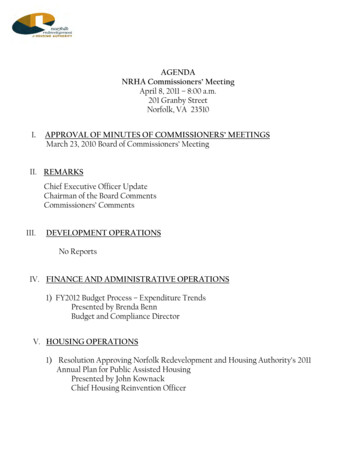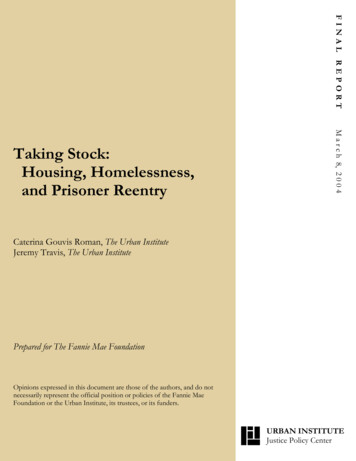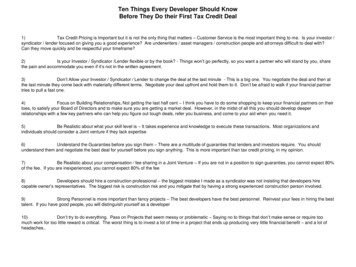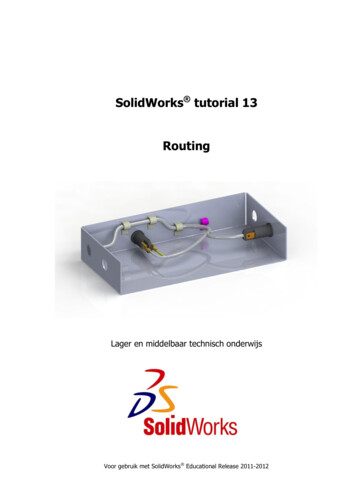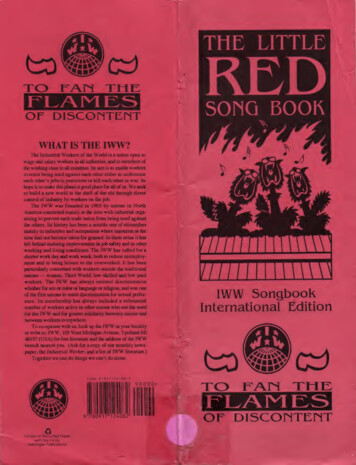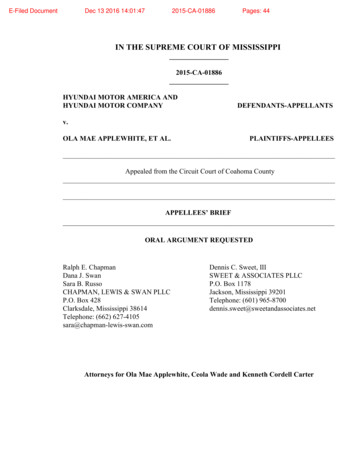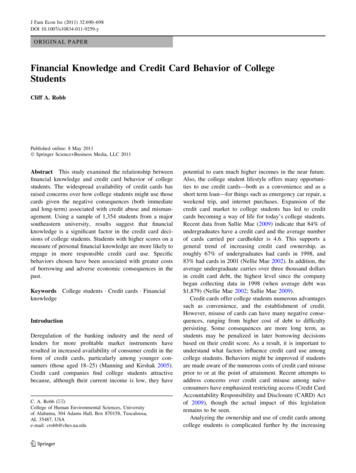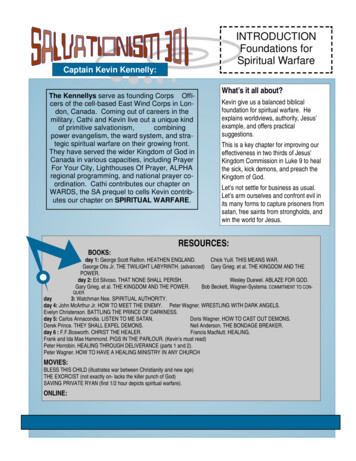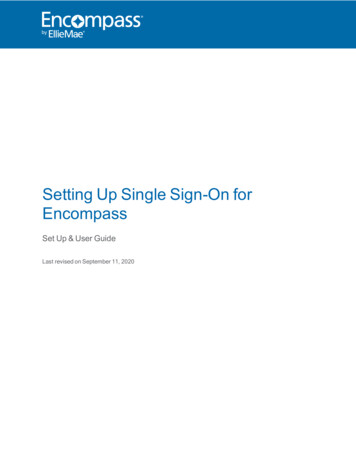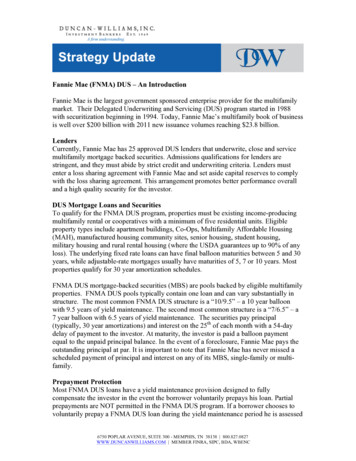
Transcription
Fannie Mae (FNMA) DUS – An IntroductionFannie Mae is the largest government sponsored enterprise provider for the multifamilymarket. Their Delegated Underwriting and Servicing (DUS) program started in 1988with securitization beginning in 1994. Today, Fannie Mae’s multifamily book of businessis well over 200 billion with 2011 new issuance volumes reaching 23.8 billion.LendersCurrently, Fannie Mae has 25 approved DUS lenders that underwrite, close and servicemultifamily mortgage backed securities. Admissions qualifications for lenders arestringent, and they must abide by strict credit and underwriting criteria. Lenders mustenter a loss sharing agreement with Fannie Mae and set aside capital reserves to complywith the loss sharing agreement. This arrangement promotes better performance overalland a high quality security for the investor.DUS Mortgage Loans and SecuritiesTo qualify for the FNMA DUS program, properties must be existing income-producingmultifamily rental or cooperatives with a minimum of five residential units. Eligibleproperty types include apartment buildings, Co-Ops, Multifamily Affordable Housing(MAH), manufactured housing community sites, senior housing, student housing,military housing and rural rental housing (where the USDA guarantees up to 90% of anyloss). The underlying fixed rate loans can have final balloon maturities between 5 and 30years, while adjustable-rate mortgages usually have maturities of 5, 7 or 10 years. Mostproperties qualify for 30 year amortization schedules.FNMA DUS mortgage-backed securities (MBS) are pools backed by eligible multifamilyproperties. FNMA DUS pools typically contain one loan and can vary substantially instructure. The most common FNMA DUS structure is a “10/9.5” – a 10 year balloonwith 9.5 years of yield maintenance. The second most common structure is a “7/6.5” – a7 year balloon with 6.5 years of yield maintenance. The securities pay principal(typically, 30 year amortizations) and interest on the 25th of each month with a 54-daydelay of payment to the investor. At maturity, the investor is paid a balloon paymentequal to the unpaid principal balance. In the event of a foreclosure, Fannie Mae pays theoutstanding principal at par. It is important to note that Fannie Mae has never missed ascheduled payment of principal and interest on any of its MBS, single-family or multifamily.Prepayment ProtectionMost FNMA DUS loans have a yield maintenance provision designed to fullycompensate the investor in the event the borrower voluntarily prepays his loan. Partialprepayments are NOT permitted in the FNMA DUS program. If a borrower chooses tovoluntarily prepay a FNMA DUS loan during the yield maintenance period he is assessed6750 POPLAR AVENUE, SUITE 300 - MEMPHIS, TN 38138 800.827.0827WWW.DUNCANWILLIAMS.COM MEMBER FINRA, SIPC, BDA, WBENC
a prepayment fee1 that is designed to compensate the investor for the spread overTreasuries that would have been earned had the loan not paid off before the end of theyield maintenance period.Involuntary prepayment from a default is the only situation that would negatively affect aFNMA DUS’s cash flow because the investor is not compensated for the earlyprepayment, but is paid off before the intended maturity date at par. Defaults have beenrare, and the Serious Delinquency Rate (60 ) is only 0.46% of all outstanding loans.Once again, the superior performance of FNMA DUS is due to the underwriting criteriarequired of borrowers and the loss sharing that puts the FNMA DUS lender’s own capitalat risk on each loan they service.InvestorsAlmost all investors can benefit from FNMA DUS in their portfolio. Insurancecompanies and pension funds can gain from the products stable cash flows that permitthese institutions to match future liabilities. Money managers like the positive convexityof multifamily MBS; it helps mitigate the negative convexity of single-family MBS.Traditional bond investors like the strong prepayment protection and the higher yieldsversus similar duration high-grade corporate and agency bonds. For depositoryinstitutions, FNMA DUS securities have the same 20% risk weighting, as do singlefamily FNMA MBS. Finally, for state and local governments that must abide byrestrictions in their investment guidelines, FNMA DUS securities offer credit quality,prepayment stability and a variety of maturities.For financial institutions and pension funds looking to maintain a barbell position,FNMA DUS securities provide a great investment alternative for the longer end of theyield curve. Examples of longer duration structures include 15/14.5, 20/19.5, and 30/15.For those investors who require shorter maturities, 5 and 7 year structures are availablealong with numerous outstanding secondary issues that should fit these same needs.In addition, for those portfolio managers that foresee a margin squeeze for theirinstitution in the coming years as rates stay low or flat, FNMA DUS securities offer anopportunity to lock in attractive spreads now with limited extension risk. As shown thechart below, FNMA DUS securities have historically maintained an attractive spread totreasuries.1The prepayment fee is the greater of 1% of the unpaid principal balance, or the unpaid balance times the present valueof the difference between the mortgage note rate and either the yield on a pre-specified Treasury note or an applicableTreasury CMT (Constant Maturity Treasury). For all loans originated after September 2009, the calculations will bewith CMT. The FNMA DUS investor would receive the portion of the yield maintenance penalty paid, which iscalculated using the pass thru rate on the security rather than the mortgage note rate.6750 POPLAR AVENUE, SUITE 300 - MEMPHIS, TN 38138 800.827.0827WWW.DUNCANWILLIAMS.COM MEMBER FINRA, SIPC, BDA, WBENC2
Community Reinvestment Act (CRA)For depository institutions, FNMA DUS securities may qualify for CRA credits. Manyfinancial institutions are investors in FNMA DUS where the underlying collateralproperty has either restricted rents to low-to-moderate income individuals or is in a lowto-moderate income census tract. The properties could be either Section 8 or Low IncomeHousing Tax Credits, whereby partial equity in the loan transaction has come from thesale of Low Income Housing Tax Credits that were issued by the state. To comply withthese Tax Credits borrowers must restrict rents in their properties to low and/or moderateindividuals who earn 60% of the area median income or less. In either case, theCompliance Officer at the investing institution should make the decision as to whether aninvestment in FNMA DUS meets the CRA needs of his bank.6750 POPLAR AVENUE, SUITE 300 - MEMPHIS, TN 38138 800.827.0827WWW.DUNCANWILLIAMS.COM MEMBER FINRA, SIPC, BDA, WBENC3
ConclusionTo conclude, FNMA DUS securities can be a valuable and attractive addition to anyinvestment portfolio. Some of the features highlighted in this discussion are as follows: Aaa/AA rated credit strength due to Fannie Mae’s guarantee of timely paymentof principal and interest Pools are backed by loans on existing, income-producing multifamily properties FNMA DUS lenders required to share risk of loss if default occurs Limited prepayment and extension risk Stable monthly cash flows that are easy to model on Bloomberg Wide variety of maturity and amortization options (5-30 years) Lower spread volatility relative to other products Greater yield versus similar duration agencies and corporates Targeted affordable properties may be suitable CRA investments for banks Liquidity enhanced from large number of dealers involved in market makingDuncan-Williams, Inc. (DW) has purchased almost 20 billion in DUS since 2009making us the largest investor outside Fannie Mae. We have been an active market-makerin the FNMA DUS market since 1998 and have established the DW name within theFNMA DUS community. DW supports both the origination and distribution of theproduct and makes a market for all 25 approved lenders. For more information call yourDuncan Williams representative today.Sources:FNMA November 1, 2011 article titled “Basics of Multifamily MBS”FNMA September 2011 MBSenger article titled “Over Twenty Years of Multifamily Mortgage FinancingThrough Fannie Mae’s Delegated Underwriting and Servicing (DUS) Program”Geetika BansalSenior Market AnalystFixed Income Strategies & Services.Catherine FolkMarket AnalystFixed Income Strategies & Services6750 POPLAR AVENUE, SUITE 300 - MEMPHIS, TN 38138 800.827.0827WWW.DUNCANWILLIAMS.COM MEMBER FINRA, SIPC, BDA, WBENC4
Chad McKeithenManaging ika BansalSenior Market Analyst901.435.4016gbansal@duncanw.comChris KlassSenior Market Analyst901.260.6810cklass@duncanw.comCatherine FolkMarket ainesvilleHoustonJacksonMemphisNew YorkPhiladelphiaTampaDisclaimer: This material has been prepared by Duncan-Williams, Inc., memberFINRA/SIPC (Duncan-Williams"), from information sources believed to be reliable.Duncan-Williams expressly disclaims any and all liability which may be based on suchinformation, errors therein or omissions there from, or in any other written or oralcommunication related thereto. This material is for your information only and should notbe construed as investment advice or as any recommendation of a transaction. NeitherDuncan-Williams nor any of its representatives is soliciting any action based upon thismaterial. Specifically, this material is not, and is not to be construed as, an offer to buyor sell any security or other financial instrument referred to herein.6750 POPLAR AVENUE, SUITE 300 - MEMPHIS, TN 38138 800.827.0827WWW.DUNCANWILLIAMS.COM MEMBER FINRA, SIPC, BDA, WBENC5
of the difference between the mortgage note rate and either the yield on a pre-specified Treasury note or an applicable Treasury CMT (Constant Maturity Treasury). For all loans originated after September 2009, the calculations will be with CMT. The FNMA DUS investor would receive the portion of the yield maintenance penalty paid, which isFile Size: 211KB
